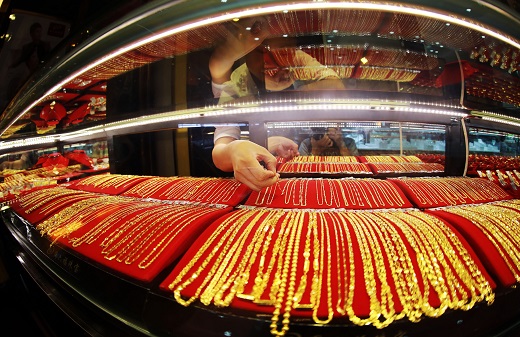|
|
Lunar Festival Seals China’s Comeback
Mar 9, 2021 9:49 AM
By Joshua Freedman
|
|
|

RAPAPORT... The Chinese New Year of 2020 could not have come at a worse time for the jewelry industry. The spread of the coronavirus across China — and beyond — was suddenly becoming a major threat to public health. Stores shut, and consumers canceled their travel plans. Retailers reported heavy sales slumps. Diamond suppliers, especially in India, feared their Far East clients would miss payments.
Hong Kong, which relies on tourist business, suffered an almost instant hit as visitors stayed away, and has still not recovered. But the mainland, after tackling the virus early on and reopening its economy, has seen a rebound exceeding what many observers anticipated. With borders staying closed, domestic consumption has skyrocketed. The result was a far more positive lunar festival in 2021.
Sales at key retail and catering companies rose 29% to CNY 821 billion (about $126 billion) for the seven days from February 11 to 17 — including the Chinese New Year — compared with the 2020 festive period, the country’s Ministry of Commerce said last month. Jewelry revenues soared 161%, partly because this year’s season coincided with Valentine’s Day.
“Sales [to retailers] before the Chinese New Year were above expectations,” said Rahul Jauhari, senior vice president of global sales and marketing at Star Rays, a Mumbai-based diamond manufacturer. “China’s comeback has been strong. One of the big reasons has been pent-up demand. Everyone wanted to stock up.”
Most of the growth came from gold, a staple investment asset for the Chinese market that has gained popularity amid rising prices of the metal and economic uncertainty, industry members said. But diamond sales were also better than a year ago, with round, 0.30- to 1-carat, D- to I-color, VS- to SI-clarity goods in strong demand, they added.
The government did not provide data on diamond sales, but the category was “very positive,” said market analyst Julius Zheng.
“During the Chinese New Year, some of the major gold-jewelry retailers reported a 500% year-on-year increase in sales,” Zheng elaborated. “Diamond jewelry is a relatively new jewelry type, which started in the 1990s, but it’s getting more and more important in China.”
Consumers see gold as the priority, and buy diamonds if they have more cash available, explained Ephraim Zion, founder of Hong Kong-based Dehres, a supplier of high-end diamonds, gemstones and jewelry. Gold jewelry contributed the greater part of the festive rebound, he concluded.
“[The Chinese] haven’t been buying for a long time. They feel bored, [so] they buy gold and they buy [diamond] jewelry, as well,” Zion commented. “Those who are well-to-do buy both. Those who are in the middle-to-lower class, if they have a little bit of money saved, they buy gold.”
Replacing inventory
Following the sales spike, restocking of diamonds and other jewelry components is happening at a faster rate for this season than in either of the past two years, observed Shanghai-based Chen Shen, president of Skywalk Global, a gemstone dealership and consultancy firm.
“They’ve already started [restocking],” Shen said. “The jewelry factories that I have talked to are all very busy, because they’ve got orders in. When you have demand for gold, at the same time you also have demand for diamonds.”
The replenishments are focused on the polished articles that were in demand during the season, noted Vipul Sutariya, director of sales and marketing at Indian polished manufacturer Dharmanandan Diamonds.
“The Chinese New Year was good — fantastic for some,” Sutariya said. “Nobody is saying it was average or less than average. So everybody’s expectations were met, or it was above their expectations. We have seen some restocking activities. There’s good demand in China, overall.”
Now retailers have their eyes on the Labor Day holiday period, which takes place in early May.
“Because May 1 is a national holiday and many people will get married, restocking will start in March,” said Zheng. “But I don’t expect that there will be aggressive restocking, because it’s taking a very long time for business to go back to normal [after the pandemic].”
Rising expectations
The region’s major publicly listed jewelers — Hong Kong-based Chow Tai Fook, Luk Fook and Chow Sang Sang — likely saw year-on-year sales increases of around 20% on the mainland for the first two months of 2021, Shen estimated. Figures in Hong Kong will have slumped, however. None of the big three — nor smaller rival Tse Sui Luen — has reported figures for the season yet.
The comparison with last year will be stark, as the giants’ dependence on physical retail impacted their performances during the peak of the crisis, the dealer and consultant explained.
“The national jewelry chains rely on sales from the retail network,” Shen asserted. “During the first half [of 2020], they suffered more than small jewelers, whose sales rely on personal relationships. So the small companies did relatively well during the whole of 2020.”
Last week, the Chinese government forecast 6% growth in gross domestic product (GDP) for the year, although analysts have predicted a sharper rise of up to 8%. This bodes well for consumption in the coming year, according to Shen.
“Jewelry sales started kicking [in] after September. October, November, December were very good,” he said. “Everyone I know is doing good business.”
Image: A jewelry store in Beijing, China. (Shutterstock)
|
|
|
|
|
|
|
|
|
|
Tags:
and Chow Sang Sang, Chen Shen, China, Chinese New Year, Chow Tai Fook, Dehres, Dharmanandan Diamonds, Ephraim Zion, Joshua Freedman, Julius Zheng, Luk Fook, Lunar Festival, Ministry of Commerce, mumbai, new year, Rahul Jauhari, Rapaport News, shanghai, Skywalk Global, Star Rays, Tse Sui Luen, Vipul Sutariya
|
|
|
|
|
|
|
|
|
|
|

|
|